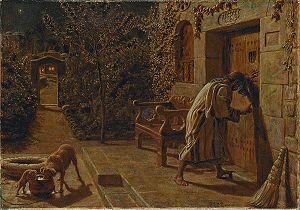Parable of the Friend at Night

The Parable of the Friend at Night (or of the Importunate Neighbour) is a parable told by Jesus in the New Testament, found in Luke Luke 11:5–8, and depicted by several artists, including William Holman Hunt.
Narrative
The parable is as follows:
And he said to them, "Which of you who has a friend will go to him at midnight and say to him, 'Friend, lend me three loaves, for a friend of mine has arrived on a journey, and I have nothing to set before him'; and he will answer from within, 'Do not bother me; the door is now shut, and my children are with me in bed. I cannot get up and give you anything'? I tell you, though he will not get up and give him anything because he is his friend, yet because of his impudence he will rise and give him whatever he needs."
— Luke 11:5-8, English Standard Version
The scene described in this parable suggests a single-roomed peasant house, where the whole family sleeps together on a mat on the floor,[1][2] and a man travelling by night to avoid the heat of the day.[2]
Interpretation
This parable appears in the Gospel of Luke immediately after Jesus teaches the Lord's Prayer, and can therefore be viewed as a continuation of Jesus teaching his disciples how to pray,[1] while the verses which follow help to explain the meaning of the parable:
"And I tell you, ask, and it will be given to you; seek, and you will find; knock, and it will be opened to you. For everyone who asks receives, and the one who seeks finds, and to the one who knocks it will be opened."
— Luke 11:9-10, English Standard Version

Joel B. Green suggests that the question that opens the parable ("Which of you who has a friend...?" also expressible as "Can you imagine...?") is intended to be answered as an emphatic "No!", since no friend would refuse to help under such circumstances[1] (the opening words in Greek occur elsewhere in Luke, but have no contemporary parallels, and I. Howard Marshall regards them as probably characteristic of Jesus himself[2]). However, Jesus goes on to point out that even if friendship wasn't a big enough motivation, help would still be forthcoming.[1] As with verses Luke 11:9–13, the parable is therefore an incentive to pray.[2] The parable of the Unjust Judge has a similar meaning.[3]
Depictions
There are a number of depictions of this parable, the most famous being The Importunate Neighbour (1895) by William Holman Hunt, held in the National Gallery of Victoria, Australia.
References
- ^ a b c d Joel B. Green, The Gospel of Luke, Eerdmans, 1997, ISBN 0802823157, pp. 445–450.
- ^ a b c d I. Howard Marshall, The Gospel of Luke: A commentary on the Greek text, Eerdmans, 1978, ISBN 0802835120, pp. 462–465.
- ^ Craig L. Blomberg, Interpreting the Parables, InterVarsity Press, 1990, ISBN 0830812717, p. 275.
